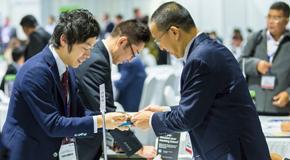
Japan is a polite society that places great importance on harmony and personal responsibility. Its customs can appear complex to foreigners so it will be useful to familiarise yourself with them before you go.
Introductions
- Greetings should be delivered enthusiastically. A common greeting before 11am is ‘ohayō gozaimasu’ but it can be used at any time of day if you’re meeting someone for the first time.
- ‘Konnichiwa' means good day or good afternoon and ‘konbanwa’ means good evening.
- Use both hands to give and receive business cards.
- It is a sign of respect to examine a business card before putting it on the table or in a business card case. Don’t put it away immediately or place it in your pocket or wallet.
- ‘Sayonara’ means goodbye.
Bowing
- Bowing is very important in Japan. It is used as a greeting and for thanking and apologising to people. The strongest respect is shown by the longest and deepest bow.
- Bows are performed with a straight back and with the eyes looking down.
- Males keep their hands at their sides females clasp their hands in their laps.
- Informal bows are made at about a fifteen degree angle or a tilt of the head.
- Formal bows are made at about thirty degrees and can be deeper.
- Someone who is of an inferior rank (by age or job title) will bow for longer, more deeply and more frequently.
- However, many Japanese people will shake hands with foreigners so they won’t be offended if you don’t understand all of the intricacies of bowing.
Communications
- The title ‘-san’ is placed after the first name of adults and ‘-sama’ is used for customers.
- Never use red ink as this signifies wanting to bring death upon someone.
Gifts
- It is a good idea to bring gifts from your own country to thank Japanese people.
- Avoid items that display the numbers 4 and 9. They are considered to be unlucky as they represent death and suffering.
- White flowers are inappropriate because they are associated with funerals and bereavement.
Meals
- Never rub your chopsticks together or place them standing up on your plate.
- Pouring soy sauce onto rice or directly onto sashimi or sushi is not a Japanese custom.
- It is rude to pick out some ingredients and leave the rest.
- It is acceptable to lift soup and rice bowls to your mouth.
- Slurping your noodles or soup is a sign that you’re enjoying the meal.
- Finishing your meal so there is no food on your plate is a sign that you don’t want to be served any more.
- Leaving food on your plate is a sign that you would like another helping.
- If you use a toothpick cover your mouth at the same time.
- Saying ‘kam-pai’ before drinking means cheers.
- It is rude to refill your own glass. You should fill your colleagues’ glasses when they are empty.
- Some restaurants with straw matting on the floor require visitors to take off their shoes.
- It is rare for money to change hands in Japan - bar and restaurant bills are paid at the till. There will be a small bowl which is used to place your credit card or money.
- There is no tipping in Japan.
- Eating and drinking while walking is thought to be uncouth.
Other behaviour
- Don’t blow your nose in public or use a handkerchief. Sniffling is considered to be acceptable.
- If a building has a sunken entrance and there is footwear by the door you will be expected to remove your shoes. They must always be taken off when entering someone’s home, traditional buildings and temples.
Remember that Japanese people won’t expect you to know all of their customs and protocol but they will appreciate it if you make the effort. Enjoy your stay in Okinawa!
Routes Asia 2017, 19-21 March, Okinawa Convention Centre, Okinawa, Japan.
